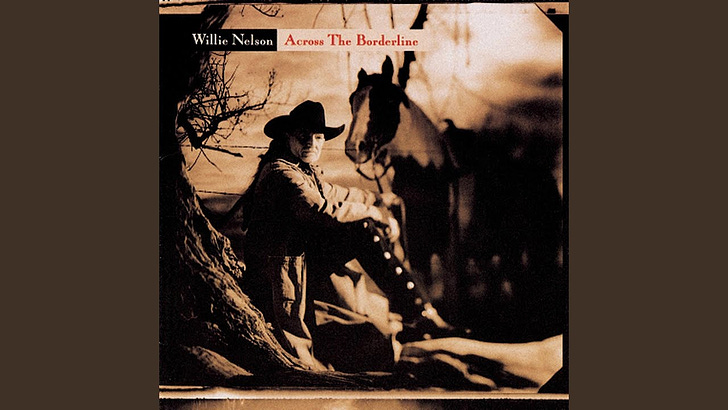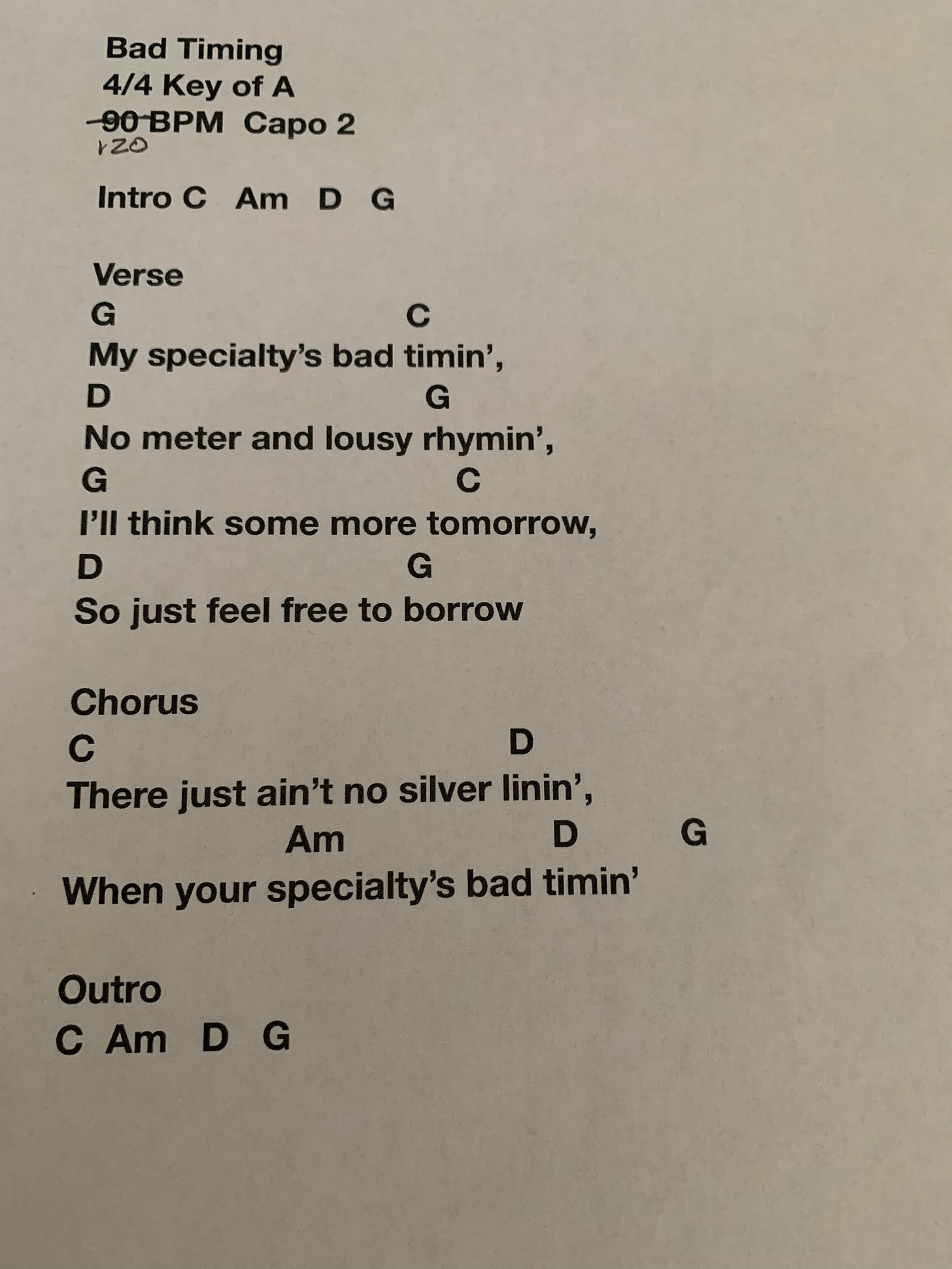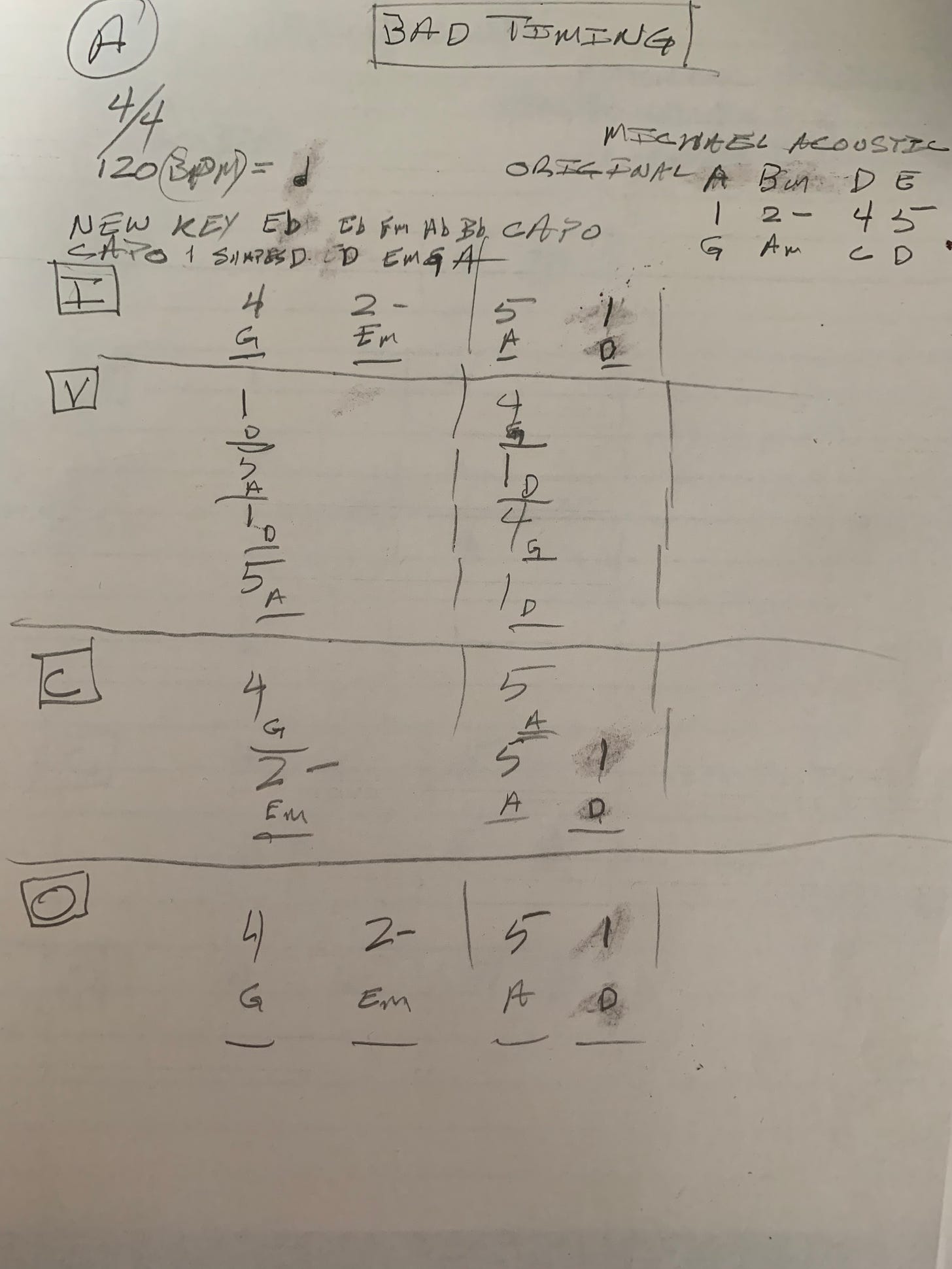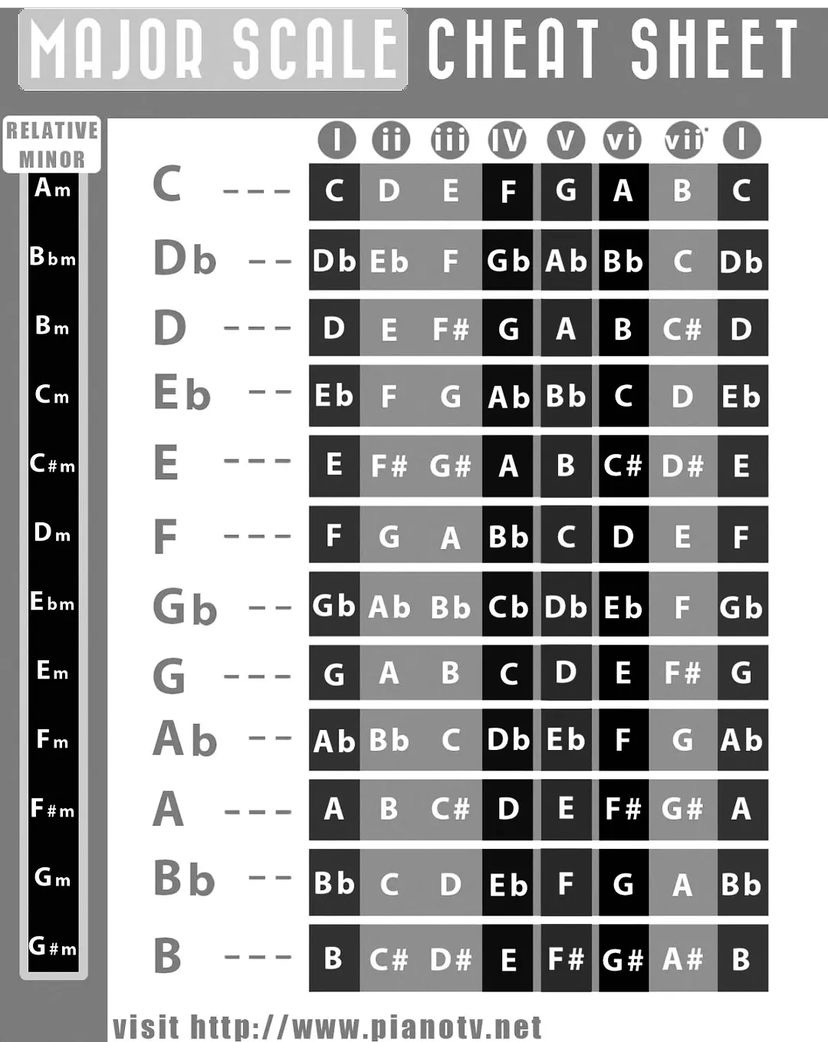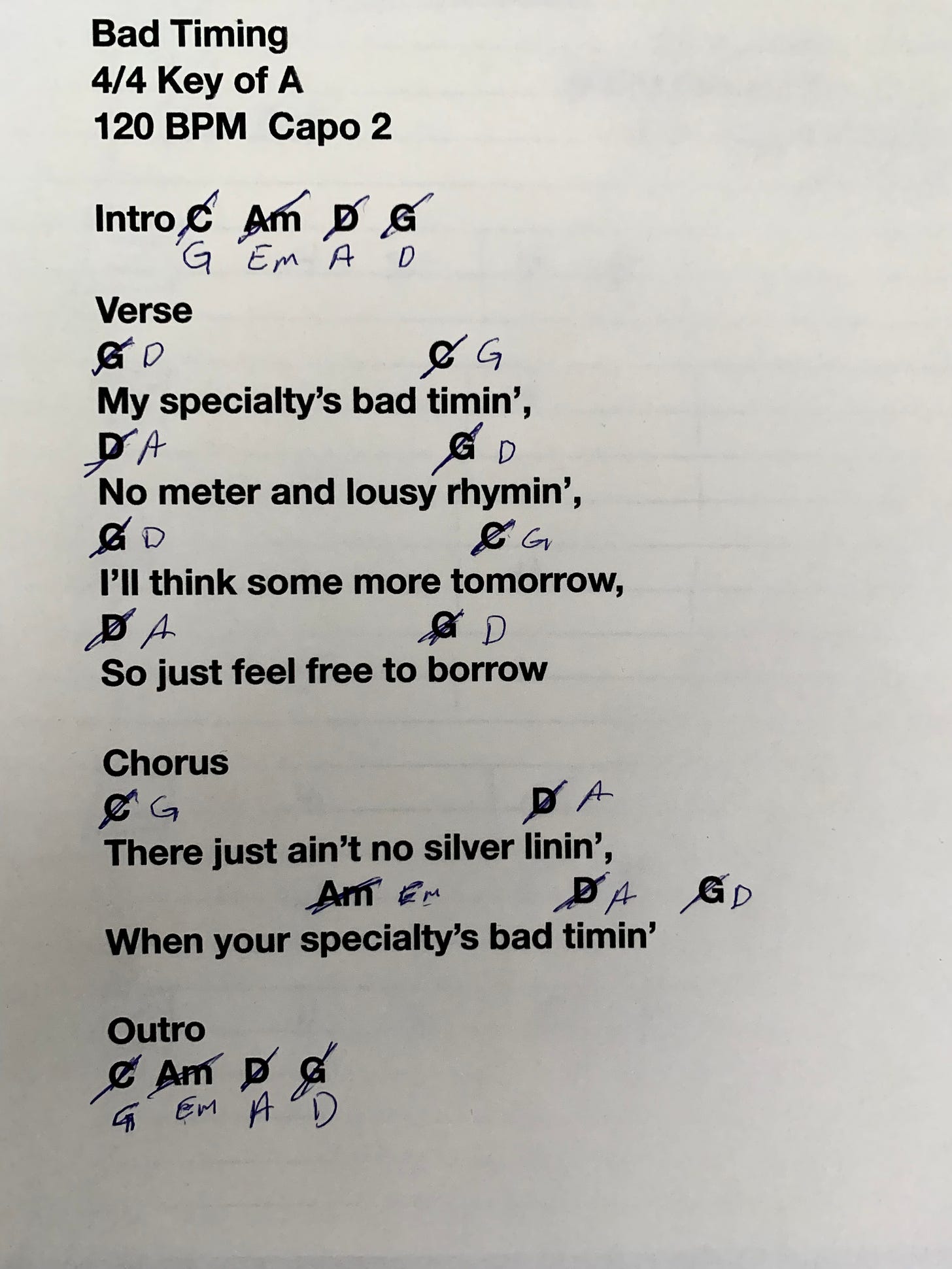Willie Nelson’s cover of Paul Simon’s “American Tune” - a followup to last week’s Bonus Round, just because I like this version too!
Yesterdays Bonus Round: The question “Why, Mr. Metheny…? is answered with “Don’t Know Why”, an acoustic instrumental on Pat Metheny’s 2003 album “One Quiet Night”. The Pat Metheny version is a cover of a song by Jesse Harris released on the album Jesse Harris & The Ferdinandos (1999). Another cover of the song was a huge hit for Norah Jones in 2002.
So, for today we’re going to walk through the Nashville Notation system using the example of the “silly song”, “Bad Timing” from a previous post. As a refresher. here’s the chord chart for “Bad Timing”.
For the story behind this, you can revisit the original post at:
So for the walk-through today, we’ll imagine our small band has decided we need a filler song in our set lasting a minute or so and, somewhat hilariously, has chosen “Bad Timing” for that purpose. Originally in the Key of A, we capoed on 2 to play the easier “G” chord shapes. Our imaginary vocalist decided we should now do the song in the Key of Eb.
Okay…..
So, we set to work with a blank piece of paper and after some scribbling, erasing, and more scribbling, come up with this:
Rather than put you through the torture of trying to read that mess, I typed it out. Note this is for illustrative purposes only - you would likely never waste your time doing this is the real world. Everything you need to update your chord chart to the new key is in there, abeit somewhat messy and barely legible.
A shoutout here to SubStack support, .pdf files aren’t “embedable” in posts as just the document itself, but they do allow writers to “drag and drop” the file into the post, which generates the “Read now” boxes you see below. A little clunky, but we’ll just have to go with it. Also, the fabulous Georgia at SubStack support got back to me with a quick response to my question about embedding audio files in posts. Not available yet, (though its doable in “Podcast” mode apparently - a little too complicated for me!), so you won’t be able to hear my scratchy, one take voice memo of me singing and playing “Bad Timing”. No great loss, I assure you!
So the header section follows the template I linked to yesterday in a .pdf, if you missed it yesterday, here’s another link to it.
Here’s the Header and Intro portion in a typed out version of the handwritten notation above for clarity:
You’ll see I followed my template with an added and improvised section for the “New Key” chords, which looked kinda scary, so I also added a section for the new chords capoed on 1, to play in the Key of Eb, but now using the DMaj key’s chord shapes.
That’s a great example of how the template is really just a suggestion. Use and customize the Nashville Notation system to fit your needs, and that may mean customizing, even making up your own parts on the fly to accomplish whatever needs to be done today!
For reference, I used this chord “Cheat sheet” from a previous post to review the 1, 2-, 4, and 5 chords of the Key of Eb (that our singer wants to change to, for some reason):
To recap the original Key and capo for “Bad Timing”: it was writen in A, (check the “A” line) and using the I, ii-, IV, and V chords, translated to Nashville numbers as 1, 2-, 4, and 5. Then I capoed on 2, giving me the corrsponding chord “shapes” of the “G” line above.
Now I need to find the corresponding chords on the “Eb” line - they are Eb, Fm, Ab and Bb as the 1, 2-, 4, and 5. Those chords are toooo scary for me, so I capoed on 1 in the new key, to the 1, 2-, 4, and 5 “shapes” of “D” line above, letting me play the much easier DMaj, Em, GMaj and AMaj “shapes”.
Great! Now all that’s left is to put in the Nashville numbers for the the other sections. As you can see in the “Badtimingnashville.pdf” above, I also chose to include the new, capoed chord names on the line below the Nashville numbers so it will be easier for me to “pen and ink” the original printed chord chart (you’ll see that in a picture below).
So the typed out version (for readability) of the whole Nashville chart looks like this with the Verse, Chorus and Outro sections added in Nashville numbers, with the new capoed chords highlighted below:
Finally, here’s the original chord chart with “pen and ink” changes that show the Key of Eb chords, but now capoed on 1 giving me the easier DMaj chord “shapes” to play in Eb.
Is it great? Not really, but it would likely get me through a rehearsal (or even a performance) until I could get home, change the original chart by replacing the typed chords and printing a new chart. I’d certainly keep a file copy of the original in case our singer later decided it sounded better in the original Key of A….
Is it fast? Unless your bandmates are standing around staring at you and tapping their feet while you work, yes, with a little practice and key and capo conversion charts at hand, probably fairly quick to do, though this is a really short example. I’d urge you to practice a few times with “real” songs - I used to do them on the back of chord charts for practice, especially if I got the feeling it was one the vocalist might well want to change keys in.
I spoke to some musician friends this week about Nashville notation and whether they’d used it, seen it, or how they did key changes if they hadn’t. My drummer friend was somewhat familiar with it, and then laughed a lot in pity at other players who might have to actually use it. Gotta love drummers…
A friend who plays piano and keyboard (and teaches and is an experienced and fabulous all around musician) was not particularly familiar with it, but had some really interesting insights. She recommended thinking of the melody in “solfège”, analyze that for harmony and pay attention to phrases and cadences. Yep. Way above my abilities, but I have a vague notion of what she means and I’m going to practice with it.
In simple terms, “solfège” is singing the familiar “do-re-mi” song in different scales (keeping in mind the difference between a scale - individual notes, and a key - chords “rooted” on the notes of that scale). Here’s a link with a much more detailed description:
So, we covered a lot today, and hopefully learned something new and interesting along the way. Drop a comment below if you have questions - I’ll try to find answers!
Some interesting links:
Bonus Round: This gorgeous acoustic song by a fantastic female singer/songwriter!!
Remember the clue’s in the subtitle above!!
Cheers!!
Michael Acoustic


